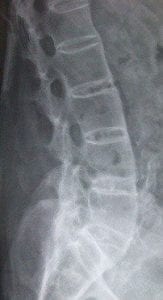
When we are in pain, we want to fix the problem, and as soon as possible. While this is understandable, it is important to keep in mind that healing can take time, especially if we are older. We may want to rely on pain relief medication to keep the aches and sharp pains away. While surgery and pain pills may alleviate some problems, they also have the potential to create other issues.
Let’s look at surgery first. This video of the anatomy of the normal spine shows you how its many components work to support your body, bend to give you flexibility, and serve as the channel and “distribution center” for your sensory and motor nerves:
One of the most common surgical procedures for back problems is a lumbar fusion which fuses two or more vertebrae into one unit. While this does help some patients, the resulting lack of mobility may be a disadvantage, and not a benefit, and the expectation of pain relief may never materialize. It also puts additional stress on the levels above and below the fusion.
An analysis of workers’ compensation data provides useful measures of the efficacy of lumbar fusion surgery. In looking at the results of spinal fusion surgery, the data from a number of sources shows that these surgeries have a high rate of unsuccessful outcome. Statistically, patients who opted for fusion surgery had a 26% chance of returning to work, and 11% were classed as permanently disabled. Surgery patients continued opiate pain meds at a rate of 76%, with 41% of those increasing their use of pain meds.
On the other hand, those who chose not to have surgery had a 2% likelihood of permanent disability and missed about a quarter of the workdays that surgery patients did. Nonetheless, over a 15-year period, the number of lumbar fusion surgeries increased eight times. Is there a disconnect between the use of this procedure and the statistical results?
This does not take into consideration the need for additional surgeries once a surgery is performed. From my 33 years of dealing with so many back and neck injuries, I see surgery as a last resort.
A word about pain meds: pain is a measure of dysfunction. The point is not to ignore or suppress pain, but to use it a guide for what not to do. If your car is overheating, disconnecting the dashboard indicator will not cool your engine. Working with a physical therapist and being good to your back may not solve all your issues, but will help you manage your back problems and keep them from worsening. You still have times when inflammation “heats up” your pain indicator, but you can acquire the tools to handle the problem.
We strongly suggest that before you agree to any back surgery, carefully assess the risks and benefits. It is also totally within your rights and to your advantage to investigate the success rates of the surgeon, and to investigate other options. Today you can often find ratings on the internet, and much more information about how to optimize your healing process.
The most important factor in healing from painful neck and back injuries, is self help. Self education is the key. I have many posts on my blog to help you learn how to deal with back problems, with instructions for body mechanics, stretching exercises, and diet and life style.
See these posts under back injury/healing.
http://www.jstillman.com/back-health-pain-injury/
http://www.jstillman.com/serious-back-injuries-from-truck-accidents/
At Stillman and Friedland, we know recovery is about more than financial compensation, it’s about your quality of life.
Because we care…
Jay Stillman
Injury Attorney
615-244-2111
jay@jstillman.com
* This blog entry should not be construed as medical advice or treatment for any specific condition. Only a licensed medical professional can properly diagnose and treat medical conditions. If you have any question regarding your health, please consult with your healthcare provider.






